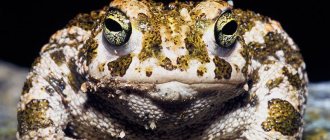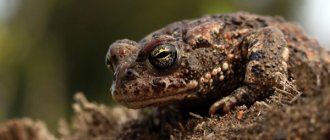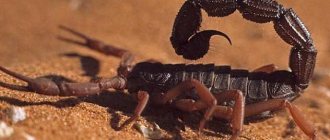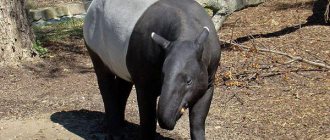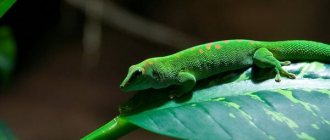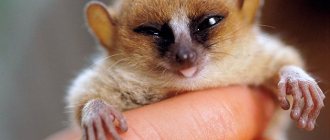Toads are one of the largest families of amphibians, comprising about 450 species living on all continents except Antarctica. There are 6 species of toads found in Russia. The most widespread toad (it is also the largest) found in our country is the common (gray) toad. It is she who has been known to all of us since childhood from pictures in books, fairy tales and fables. We will talk about it in this article.
The common toad is quite common, but much less noticeable than its relative, the green toad, whose presence is indicated by its ringing mating trill. In addition, due to its nocturnal, secretive lifestyle, it comes into view of humans much less often than, say, the frogs that live with it.
Description and features
The appearance of toads varies significantly, since there are about three hundred species of amphibians. But there are common features characteristic of tailless amphibians - a large head, short limbs placed on the sides, a flattened shape of a heavy body.
The body length of the toad varies from miniature individuals at 20 mm to giants in its family at 270 mm. Weight respectively from 50 grams to one kilogram. Females are larger than males, regardless of species.
A male can be recognized by small bumps on the front legs, which are called nuptial calluses. The main function of the leathery projections is to capture the female during reproduction.
The tongue of amphibian inhabitants is narrow and long. Upper jaw without teeth. The hearing system is well developed. A feature of male amphibians is the presence of a rudimentary ovary. Thanks to this, in certain conditions the uniqueness of toads is manifested when a male can turn into a female.
Amphibians have inconspicuous colors that allow them to blend in with their environment. Brown, gray-black, dirty green skin tones with a pattern of spots of different geometries characterize the toad outfit. The exception is the inhabitants of tropical countries, whose bright colors seem to warn of the toxic nature of the amphibian inhabitants.
The amphibian has no ribs. Distinctive skin with raised warts of varying sizes, dry to the touch. The parotid seals present in most species are called parotids. With their help, toads secrete a special secretion that protects the skin from drying out.
The second feature lies in the protective mechanism - the secreted mucus in many species is toxic and contains an alkaloid poison. When under stress, the toad is ready to defend itself from enemies in this way.
The mucus has a burning taste and an emetic effect. Animals that bite an amphibian are poisoned. Toad secretions are safe for humans, but contact of the secretion with mucous membranes can cause inflammation.
Perhaps this feature became the basis of the myth about the appearance of warts after touching a toad. Research by scientists has shown that there is no connection between amphibians and warts. All toads except the aha species, a tropical variety, are safe.
As a defense, amphibians inflate their body in front of the enemy, rise on their legs, increasing in size. The threatening posture makes it difficult to capture. Sometimes she even desperately jumps towards the enemy.
Toads are ubiquitous across all continents. There are no amphibian inhabitants only in the Arctic, Antarctic, and Greenland. In Australia, where there were no amphibians before, a population of the most poisonous aga toad was artificially created.
The natural enemies of amphibians are birds of prey, reptiles, and individual forest inhabitants. Toads cannot resist many enemies - storks, herons, ibises, hedgehogs, snakes. Their high fertility saves them from extinction.
The food addiction to insects of all types allows the use of toads to “protect” agricultural crops from annoying pests. In some countries, they specifically breed amphibians for these purposes. A wild toad, relocated to a summer cottage, with constant food available, takes root in one place and serves as a local “guard” of the crop.
Toad care rules
But communication with my English toad was not so rosy. I have had a long, antagonistic relationship with the English language. They started with the first mark in the 5th grade, which I received already in the second lesson, after I did not learn the English alphabet. A poster in the English classroom friendlyly told me that knowing this language would help me choose one of four future options. If I diligently learned English, I could become:
- sea captain;
- flight attendant;
- librarian;
- English teacher.
None of the proposed options appealed to me.
Moreover, at that time, a significant part of the population of my country, including me, believed that in the very near future the Russian language would become a compulsory subject in schools in the USA and Great Britain. By the middle of 9th grade, I finally realized that my brain was completely incompatible with the English language. The impending single “three” in the second quarter threatened to poison the entire New Year holidays. Something had to be done and I made one last attempt to retake. My teacher met me halfway. After I retold the text that we had been studying for the fifth year, she was silent for a long time, and then said: “Sasha, out of everything you said, I only understood two words: “octouba” and “revolution.” The institute only added to my confidence in the absoluteness of my linguistic inferiority.
After graduating from college, my natural laziness and aversion to doing routine work forced me to get into programming. Despite the catastrophic lack of Russified programs in those years, for a long time I managed to imitate an intelligent person in a rapidly Anglomorphizing world. And suddenly, at a certain stage, I was surprised to realize that I was reading error messages from my programs without a dictionary. I suddenly realized that not everything in life was lost, and I began frantically buying self-instruction books and computer programs that promised to take me to a whole new level. But for some reason the new level did not occur. Apparently, because each time the newly started training using the next breakthrough method ended around the third lesson. True, this knowledge was enough to simulate passing the candidate minimum, but no more. Over time, the feeling of linguistic inferiority dulled, but did not go away, from time to time briefly aggravating with the purchase of another self-instruction manual.
The next insight happened after one of my colleagues advised me to watch Dmitry Petrov’s course “Polyglot. Learn English in 16 hours!" and try to study on the recently launched resource Lingualeo.ru. Despite the fact that the name of the course itself did not bode well, I forced myself to watch the first lesson and was stunned. Hugh Hoyland must have had a similar feeling when Jo-Jim first showed him the stars. I realized that the impossible is possible.
Dmitry Petrov's lessons proved to the rational type that knowledge of just seven pronouns and ten verbs allows you to express your thoughts using five hundred affirmative, interrogative and negative phrases. And this is after the first lesson! Knowing a few principles frees you from the need to know many facts. It was an unconditional victory of logic over defective memory. At the same time, my monkey also did not lose money. On the one hand, she received a lot of toys, on the other hand, LinguaLeo Translator allowed her to create a personal dictionary for learning based on any texts found on the Internet. It turned out that wasted time can be turned into gain. This confidence was strengthened by my new colleague, who raised English from scratch to fluent reading, starting simply by studying the dictionary on the way to work (he studied German at school). I used to be sure that such people only exist in films. The road to work and back turned into school lessons. The calculation was primitively simple: if you learn 10 words every day, in a year you can reach the vocabulary of a hard worker from New York. I supplemented the study of words from the LingvoLeo individual dictionary with Dmitry Petrov’s simulators. I won’t say that I became a diligent student, but after some time I began to pay attention to hh.ru vacancies, which required knowledge of English. This is how I got the English toad. This toad, without any disgust, began to eat most of those cockroaches that, on the way to work and back, vying with each other to advise me to relax, find out the latest news or watch YouTube. Although the toad sometimes did not object to YouTube, where for those who had found hope and hearing, there were many videos that did not tire even the monkey: from a simple listing of irregular verbs to interesting video lessons for beginners. And soon my imagination began to picture a colossal increase in my income in the very near future.
Source
The reason for my sobering up was an incident that happened to me at the Arbatskaya metro station. I found myself there when I was returning home in full dress after a meeting in one of the ministries, feeling like Bill Gates after a meeting with the Lord God. Apparently, having noticed a faint glow above my head, a man rushed towards me in the center of the hall, waving the guidebook like a white flag. Although we were about the same height, I looked down at him condescendingly, preparing to accept his surrender. “Excuse me! - said the person, absolutely confident that he would receive an answer - Do you speak English? Probably Icarus, after he fell, hit less painfully. Despite the fact that I had absolutely no difficulty translating the question, my shell-shocked consciousness could only produce one answer: “No.” My interlocutor must have been educated in one of the Jesuit schools in Europe, because, slightly surprised, he continued the torture: “Sprechen Sie Deutsch?”, to which he received the same answer from the Red partisan. As red as boiled crayfish, literally. The last question of the inquisitor was apparently asked with the aim of finally finishing me off: “Parlez-vous français?” However, my ancestors did not conquer Europe for centuries because they were polyglots. Having released the foreigner with detailed instructions, I thought deeply. Something had to be done. After this incident, the thought that a person who does not know “modern Latin” cannot consider himself educated was firmly lodged in his head and did not allow him to sleep.
Kinds
Numerous species of toads are distributed everywhere. About a third of amphibian species live in Eurasia. Six species of toads can be found in Russia.
Common toad (gray). A large amphibian, body length up to 13 cm, widespread, known more than other species. The color is predominantly gray-brown above, with variations of dark spots. The underside is yellowish, often with a marbled pattern of a darker color. The eyes with horizontal pupils are bright orange.
The toad is found in forests of all types, steppe zones, and inhabits dry areas at an altitude of up to 3000 m. It often appears in recently plowed fields, in parks, and garden plots. The toad is not afraid of being close to humans; it takes up residence in old buildings as shelters. In addition to Russia, the common toad lives in Europe and the northwestern regions of Africa.
Green toad. The camouflage color seems to have been created by an artist - large dark olive spots with a black stripe bordered are scattered on a gray background. In addition, small reddish specks are scattered throughout the tuberous body. Body length is 5-8 cm.
Due to the undeveloped hind limbs, the amphibian rarely jumps and often moves slowly. For habitat it chooses open areas of fields, meadows, and river floodplains. It is found at altitudes up to 4500 m. The plasticity of living in different places reflects the low susceptibility to negative environmental factors.
Far Eastern toad. In Russia, the amphibian lives on Sakhalin and Transbaikalia. Unlike many of its relatives, it settles in biotopes with high humidity - in water meadows and floodplains. Large tubercles on the back are equipped with small spines.
Three wide dark longitudinal stripes decorate the toad's outfit; at the end they break into separate large spots. The abdomen is gray-yellow with small spots. Body length is 6-10 cm.
Caucasian toad (Colchian). Among the species living in Russia, the largest amphibian is with a body length of up to 15 cm. It is found only in the regions of the Western Caucasus. Prefers to settle in mountain forests and foothills.
The color of the upper part is from gray to dark brown, the spots are weakly expressed. The abdomen is much lighter. The number is significantly affected by the preservation of the habitat and the spread of the main enemy - the striped raccoon.
Reed toad (smelly). The color varies in gray-greenish tones. A stripe of a yellowish tint runs along the back. It is distinguished by a developed throat resonator. There are no spines on the tubercles. The size is quite large - up to 8-9 cm. It is more often found along the banks of reservoirs, swampy lowlands, and in places with wet thickets of bushes.
Mongolian toad. The warty skin of females does not have spines; males are armed with spiny growths. The color is quite impressive - spots of rich brown color of different geometries are located on a gray-beige background of the upper body. A light stripe runs along the middle part. Mongolian toads live on the coast of Lake Baikal, in Buryatia. Outside Russia, it is found in China, Mongolia, Korea, and the foothills of Tibet.
Among the diversity of toad species, there are unique amphibians that are on the verge of extinction. You can sometimes see representatives of rare amphibians in certain geographical areas or in zoos.
Kihansi splashing toad. The habitat of the smallest toad was along the Kihansi River in Tanzania. The construction of the dam destroyed the natural habitat of amphibians. Conservation of the species is supported only in the territories of zoos. The toad in the photo is striking in its miniature size - the size does not exceed a 5 ruble coin. Color yellow, sunny shade.
Pineal-headed toad. The species persists only in the southeastern United States. The characteristic feature reflected in the name is the presence of large swellings behind the eyes of the amphibian. Individuals are up to 11 cm in length, color varies from brown, green to gray-yellow tones. Warts are usually a shade darker than the main background. The toad settles on sandstones and semi-desert areas.
Cricket toad. It is distinguished by its modest size, body length is only 3-3.5 cm. The skin is juicy green in color and has brown-black tubercles. The abdomen is cream-colored. The species persists in Mexico.
Blomberg's toad. The length of an adult reaches 25 cm. A rare species on the verge of extinction. Few individuals are found in the tropics of Colombia.
Lifestyle and habitat
The toad is an amphibious creature that lives mainly on land - from marshy shores to arid semi-deserts. Reservoirs attract most amphibians during breeding to lay eggs. Some species, such as anzonia, are semi-aquatic, and there are also tree toads that live in trees.
They prefer a solitary existence, gathering in groups when there is an abundance of food, during the mating season. The activity of amphibians manifests itself at night; during the day, toads hide in secluded places - among stones, animal burrows, earthen depressions among plant roots.
In cloudy weather, toads can be found during the day. Proximity to humans does not bother them; they can climb into buildings and basements. In areas illuminated by electricity, at night, toads gather to hunt - to catch insects.
The wild toad the winter in hibernation, which it enters when the temperature drops, 6-8°C. The duration is approximately 150 days. Toads find secluded places different, depending on climatic conditions - under fallen leaves, deep holes, voids, rock cracks, abandoned buildings. They overwinter alone or in groups. Awakening occurs when the air warms up to 8-10°C, water 3-5°C.
Lifestyle
Common toads are nocturnal animals. The peak of their activity occurs at night, and during daylight hours they sleep or simply sit under snags of trees, between stones, in the grass or in the burrows of other animals. Boofies love to walk and hunt at night, especially in damp and rainy weather.
Gray toads are leisurely amphibians; they move very slowly, in small steps. They jump only in case of danger.
Common toads survive the winter quietly, hibernating in early autumn. Overwintering is carried out by burying itself in fallen leaves, river silt, climbing into someone's hole or into drainpipes. These animals awaken from hibernation at the beginning of spring, when the temperature remains above five degrees Celsius for some time.
Common toads do not suffer at all from lack of moisture and can easily survive a loss of thirty percent of their normal body weight. This will not harm the animal’s health at all and it will quickly recover when the right opportunity arises. To replenish the missing moisture in the body, boofi prefer to take night swims in puddles and ponds.
When danger approaches, toads stand in their special stance and swell to appear larger. These amphibians have special glands under their eyes; they secrete poison, with which the toads protect themselves from their enemies. In cases where the booby failed to escape and was nevertheless swallowed, the poison again comes to the rescue and causes a gag reflex in the predator.
The natural enemies of gray toads are snakes, large birds of prey , hedgehogs and rats.
Reproduction and lifespan
The methods of reproduction of different species of toads differ. The vast majority of amphibians undergo external fertilization. Males use a special resonator to reproduce calling sounds. The vocal sacs of different species are located behind the ears or on the throat of amphibians. In response to the calls of males, females appear near water bodies. Amphibians spawn in standing or flowing water.
The embraces of males are so indiscriminate that in addition to females, they sometimes capture wood chips and fish. After fertilization, the female lays thousands of eggs, from 1500 to 7000 eggs, connected in long cords of mucus. They entwine underwater plants and spread along the bottom of the reservoir. The length of the cords is 8-10 meters. After completed spawning, the toads return to the shore.
Embryonic development lasts up to 5 to 20 days, sometimes up to 2 months, depending on the temperature of the reservoir. Then the larvae appear, the development of which lasts about a month and a half. Outwardly, they look like fish fry, as they do not have limbs.
Each larva gradually develops into a tadpole, the size of which is up to 40% of the adult amphibian. Then a young tailless toad is formed. After completion of metamorphosis, the juveniles leave the reservoir and move to land. The movement of toads along the shore occurs day and night, so they can often be seen at this stage of life. Amphibians become sexually mature at the age of 2-4 years.
In Europe, there are species of toads where the care of the offspring is entrusted to the male. Its mission is to sit in a hole with ribbons of eggs on its legs until the tadpoles hatch. In Africa, there is a rare viviparous toad that carries its offspring for about 9 months.
Interesting Facts
- In some species, the male is most involved in the birth of offspring. It sits in an earthen hole with ribbons of caviar wrapped around its paw until the tadpoles begin to hatch.
- There is a myth that a toad can “give” a person warts. And this is absolutely untrue. All amphibians, with the exception of the aga, are completely safe for humans .
- In some countries, ground toads are specially bred to combat mosquitoes, slugs, flies and other insects.
Keeping a toad at home
Unpretentious amphibian inhabitants have become popular for home keeping in terrariums. Horizontal aquariums with amphibians are placed in shaded areas, away from loud sounds. Expanded clay and gravel are used as soil, a shelter and a small pool of water are installed.
Toads' appetite is always excellent. In captivity, their food is usually slugs, cockroaches, crickets, and special food from a pet store. For the inhabitants of the terrarium, the factor of prey movement is important, so large toads prefer mice, rat pups, chicks, and frogs. Amphibians catch insects with their sticky tongue, and larger objects with their jaws.
Some pets are so tamed that they take food from the owner's hands. kept properly at home Depending on the species, 25-30 years is not the limit for amphibians. The record holder among long-livers was a 40-year-old toad.
How is a toad different from a frog?
External similarity and general characteristics of cold-blooded creatures are the reasons why frogs and toads are confused. Differences between them are observed in body structure, habits, and habitat. The reproductive capacity of frogs is much higher.
Frogs, unlike toads, are jumping creatures and can swim well. The short legs of toads do not allow them to develop speed, so they are quiet pedestrians. The skin of frogs, without the tubercles characteristic of toads, is smooth.
It does not require moisture, unlike the dry and keratinized surface of the body of toads. Frogs can always be seen near a pond, toads are earthly inhabitants. Many people dislike frogs and toads. But studying their populations reveals many positive aspects for preserving a normal ecosystem.
Lifestyle. Nutrition
She lives alone, gathering in pairs only during breeding. They forage for food at night and hide in natural shelters during the day. These amphibians are most active during wet weather.
The common toad feeds on garden pests and their larvae, as well as small snakes and newborn mice. The main hunting tool of the gray dabby is its long sticky tongue, to which caterpillars, bugs, bugs and spiders stick. The toad is not averse to eating ants; it looks for busy paths along which it moves and begins to catch them.
If the victim is too large, strong jaws are used, with which the toad grabs and holds the prey, helping itself with its paws. Despite his good appetite, he does not eat dead animals.
Of all its relatives, the toad tolerates the cold best of all. The period of hibernation begins in mid-autumn, the gray toad takes refuge under old foliage, in the burrows of small animals, in pipes, in the thickness of coastal silt. Waking up at the beginning of spring, she heads to reservoirs and breeding grounds.
